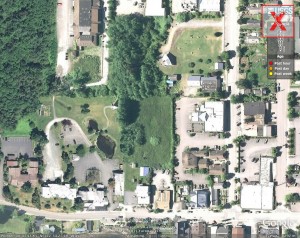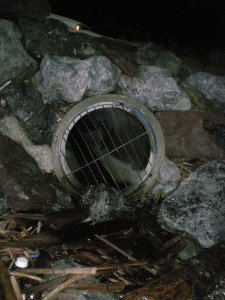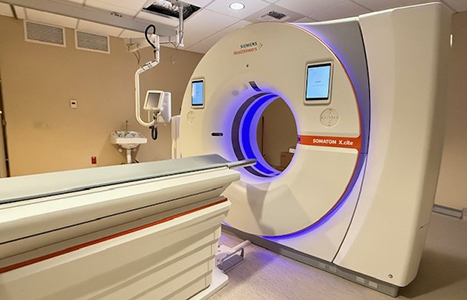
Eastsound Village from the air. Stormwater The engineered wetland treatment facility will be located in the mid portion of the large green area in the center of the view.
As part of the County Council meeting held yesterday at the Eastsound Fire Station, updates on the Mount Baker Road upgrade and the engineered wetland near the Eastsound Village Green were presented.
County staff welcomed public comment on both projects.
First, a map of the Mount Baker Road project was displayed with proposed trail upgrades. The eastern most part of the trail is located on the north side of the road so as to avoid a forested wetland on the south side. The western-most end of the trail is on the south side of Mount Baker Road. Therefore, a marked crossing of the road will be necessary. The upgraded trails will be separated from the road shoulder by a four-foot wide grass buffer.
In Eastsound, stormwater runoff from the village flows untreated into Fishing Bay. An EPA grant is funding the installation of a .93- acre engineered wetland to capture and treat village stormwater. The wetland will be sited west of the band shell in the Eastsound Village Green.
Native bushes and aspen will screen the Village Green from the wetland. A small area of natural wetland on the west side of the project will remain undisturbed, but the rest of the project will become an artificial wetland. Stormwater runoff from A Street, North Beach Road, and Prune Alley will enter a sedimentation basin at the north end of the project.
Some contaminants will be trapped in the sediment. Sediment trapping is also important because it prevents the roots of the wetland plants from being buried too deeply. The accumulated sediment will be removed annually from the basin. A pathway and bridge will lead west from the Village Green and across the wetland just south of the sedimentation basin.
To the south of the bridge, the water will flow from the sedimentation basin into a constructed wetland that will be planted with flood-tolerant native plants. Natural processes in the root zone of wetland plants can effectively treat some stormwater-borne contaminants such as surfactants, and this wetland project should significantly reduce the toxic runoff that now flows from Eastsound into Fishing Bay.
Since 2009, the Indian Island Marine Health Observatory (IIMHO) has been collecting data on the health of Fishing Bay. This data will be compared to data collected once the wetland project is functioning. Visit the IIMHO website at: www.inidanisland.info
**If you are reading theOrcasonian for free, thank your fellow islanders. If you would like to support theOrcasonian CLICK HERE to set your modestly-priced, voluntary subscription. Otherwise, no worries; we’re happy to share with you.**








